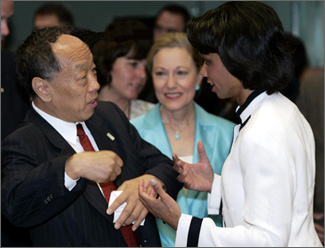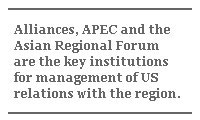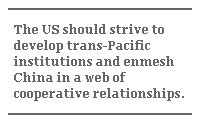Southeast Asia Casts Wide Net for Cooperation
Southeast Asia Casts Wide Net for Cooperation

Condoleezza Rice in an infrequent meeting. Asians want more
SINGAPORE: The absence of the US, the 800-pound gorilla, as East Asia moves towards the establishment of an East Asian Community, highlights the region’s changing dynamics and emerging debate over the future security architecture. Instead of trying to forge an alliance against China, as some in the US urge, American interests would have been better served by participation in the East Asian Summit that enmeshes China in the regional security network.
The East Asian Summit held in Kuala Lumpur on 14 December 2005 was a historic event whose future impact is likely to be as significant as the first ASEAN Summit held in Bali in February 1976. The first Bali Summit led to the emergence of a cohesive ASEAN 5 – Indonesia, Malaysia, the Philippines, Singapore and Thailand – in the aftermath of the emergence of communist regimes in Indo-China. The new gathering in Kuala Lumpur was underlined by the presence of a rising China and resurgent India as well as Australia, New Zealand and Vladimir Putin’s Russia. Conspicuous by its absence was the US, which has played the role of an Asia-Pacific hegemon since the end of the Second World War and is now distracted by its commitment in Iraq.

The summit’s emergence is somewhat accidental. In Vientiane last year, Prime Minister Abdullah Badawi of Malaysia offered to host an East Asian Summit involving the ASEAN Ten Plus Three (China, Japan, South Korea). Premier Wen Jiabao of China offered to host the second summit. The proposal meant that the center of gravity would move from Southeast to Northeast Asia, an unwelcome development from an ASEAN perspective. This led to a desire to include other states that had substantial interactions with the region. The participation of India, Australia and New Zealand was seen as ensuring that ASEAN remained at the center of any emerging East Asian community. India was also perceived as a balance to China. Indonesia, for example, sought to avoid aligning with China while retaining friendly ties to other powers such as the US, a classic “hedging” strategy.
The Indonesian hedging strategy and Southeast Asian wariness about being enmeshed in a new regional cold war must be understood in the context of growing antagonism between China and Japan. China continues to remind the region of Japanese expansionism during WWII; the downplaying of Japanese atrocities during the war; and the lack of Japanese remorse, as evidenced by Prime Minister Koizumi’s annual visits to the Yasukuni shrine, which includes the remains of 14 Class A war criminals. Chinese criticism has evoked a strong reaction in Japan. Most worrying is the ultra-nationalistic response of young Japanese and Chinese. Reinforcing these trends is heightened rhetoric between Chinese and Japanese decision-makers at closed-door international and regional conferences, even as substantive economic links between China and Japan increase rapidly.

While ASEAN members have had four decades of institutional experience in regional reconciliation, Northeast Asians have focused on bilateral ties and multilateral forums such as the Six Party Talks with a specific North Korean agenda. The EAS provides an opportunity for informal confidence building and functional cooperation in areas such as WMD nonproliferation, counter-terrorism, piracy, maritime joint cooperation zones as well as the establishment of an East Asian Free Trade Area. But this will take time to develop. China’s decision not to proceed with a separate summit of China, Japan and South Korea in Kuala Lumpur suggests that the ASEAN approach of using such opportunities to maintain informal contact even in the midst of bilateral differences has not yet percolated to Northeast Asians. Nevertheless, the issue of Japanese lack of atonement for WWII resonates around the region, especially in Korea and China, and could lead to Japan’s isolation.
For the US, the EAS represents a diplomatic challenge. Although the US is a leading trading partner for all EAS participants and has security relationships with significant players including Japan, the US won’t participate in the summit, as long as it is unwilling to accede to the Treaty of Amity and Cooperation, which requires agreement not to introduce nuclear weapons in the area. In any case, the ASEAN foreign ministers decided on a moratorium on new members at their April 2006 meeting. Given Bush administration priorities, it is also unlikely that the US president could be persuaded to make an annual trans-Pacific visit barely a month after the APEC Leaders’ Meeting. The US alliance system, APEC and the Asian Regional Forum (ARF) therefore remain the key institutions for the management of US relations with the region. But a reassessment of US participation in the EAS is warranted as the EAS will form part of a network of regional institutions. The US should therefore persuade East Asian states to agree to selected non-member states participating in functional cooperation programs.

The US concern with the marginalization of Taiwan has led the US to downplay the significance of China’s initiative to organize a meeting of APEC foreign ministers in Santiago in 2004. However, given East Asia’s emerging cooperative security architecture, it would be in the American interest to support a larger political and security role for APEC. APEC already has directors responsible for non-traditional security issues such as counter-terrorism, but should also appoint directors to handle issues such as supply-chain security, maritime security, energy and the environment. Such a revitalized APEC need not compete with the EAS or APT, but would be complementary. The overlapping membership of these institutions includes a core that brings together key hubs in the Asia-Pacific.
Some US analysts fret about the risk of confrontation with a rising China and the desirability of developing relationships with states on the periphery of China, such as Japan, India and Vietnam, that could balance with China. I would argue that it is probably more important today to develop trans-Pacific institutions, which could enmesh China in a web of cooperative relationships in the region. The decision to engage North Korea through the Six Party Talks is positive as US leverage on North Korea is much lower than that of traditional allies such as China and Russia.
Similarly, greater attention should be given to the ASEAN Regional Forum (ARF) process. US Secretary of State Condoleezza Rice’s decision to skip last year’s ARF meeting was a mistake. US inattention to East Asia left the field to Chinese Foreign Minister Li Zhaoxing in Vientiane. Although the risks of conflict are high in East Asia, US policy remains more focused on Europe and the Middle East.

During the Cold War, ASEAN was clearly identified with the West although nominally non-aligned. Today, as sophisticated Chinese diplomacy leads to the establishment of multiple regional organizations, ASEAN is developing closer linkages with China. These relationships are perceived as a balance against US unilateralism. Some of the newer members of ASEAN such as Myanmar, Laos and Cambodia have benefited from Chinese largesse and are supportive of Chinese concerns within ASEAN. Older members such as Malaysia, the Philippines and Thailand are beginning to bandwagon with China.
For ASEAN states that prefer a regional balance of power, a regional security architecture that is outward-looking and promotes the observance of international norms and codes of conduct is preferable to one dominated by a single power. An active US presence would sustain this vision of the region’s future.
Barry Desker is the director of the Institute of Defence and Strategic Studies, Nanyang Technological University, in Singapore. He was Singapore’s ambassador to Indonesia from 1986 to 1993 and CEO of the Singapore Trade Development Board from 1994 to 2000.